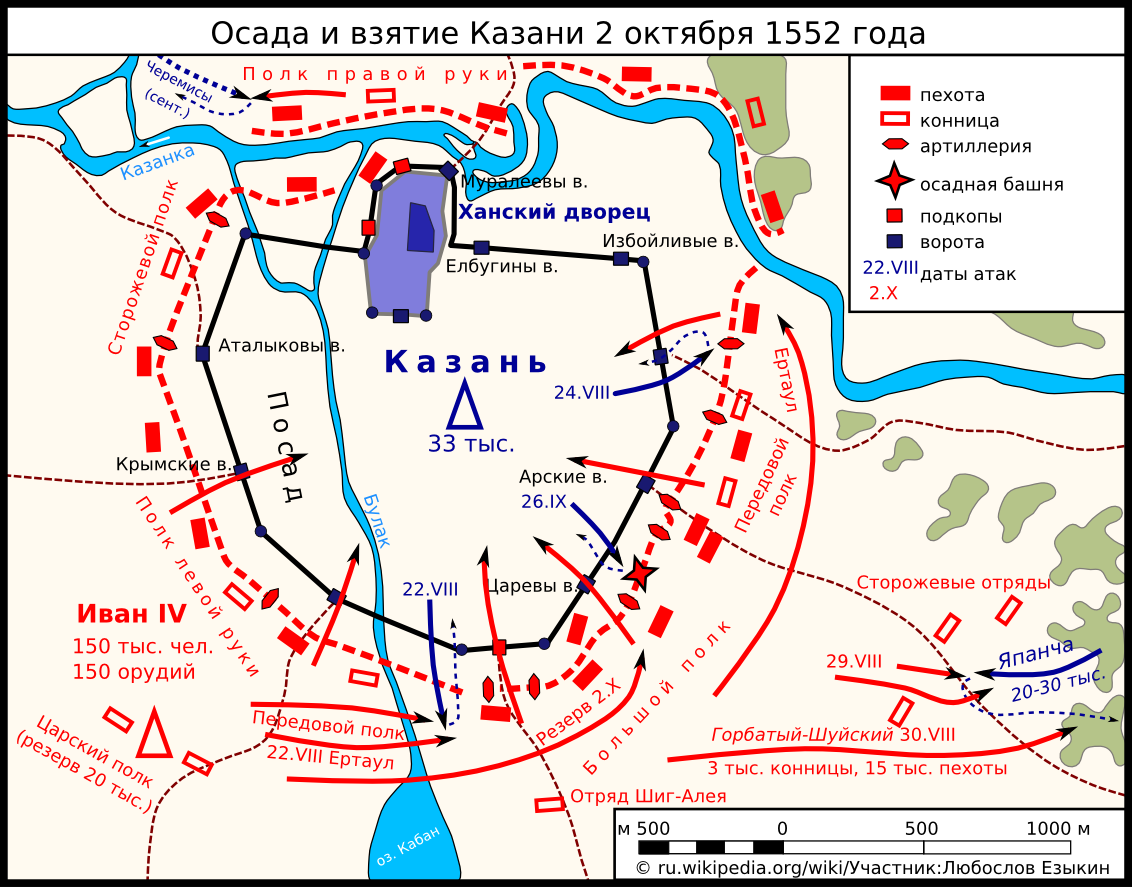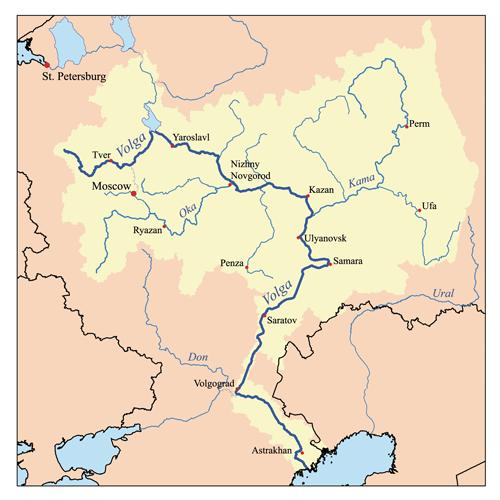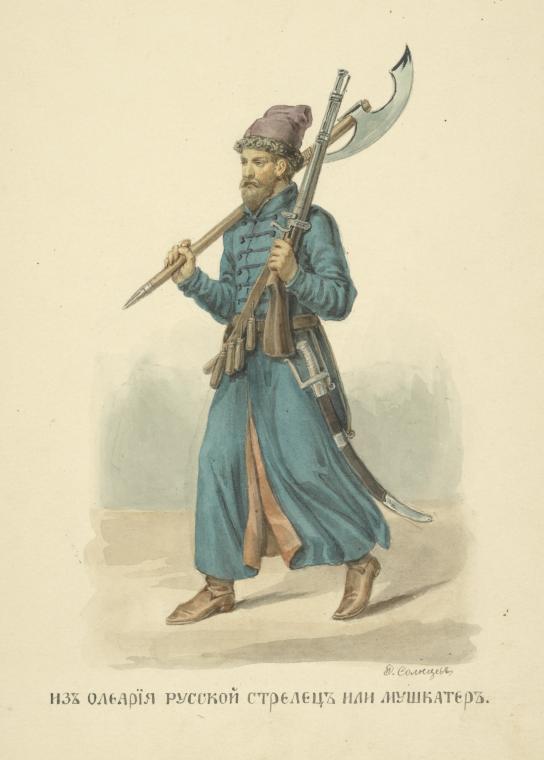|
Siege Of Kazan (1552)
The siege of Kazan in 1552 was the final battle of the Russo-Kazan Wars and led to the fall of the Khanate of Kazan. Conflict continued after the fall of Kazan, however, as rebel governments formed in Çalım and Mişätamaq, and a new khan was invited from the Nogais. This guerrilla war lingered until 1556. Background During the existence of the khanate (1438-1552) Russian forces besieged Kazan at least ten times (1469, 1478, 1487, 1506, 1524, 1530, 1545, 1547, 1549-1550, 1552). In 1547 and in 1549-1550, Ivan the Terrible besieged Kazan, but supply difficulties forced him to withdraw. The Russians pulled back and built the town or fort of Sviyazhsk. They also annexed land west of the Volga which weakened the khanate. The peace party agreed to accept the pro-Russian Shah Ali as khan. The patriotic party regained power, Shah Ali fled and Yadegar Mokhammad of Kazan was called in as khan. Religious leaders like Qolsharif inspired the people to a determined resistance. The sieg ... [...More Info...] [...Related Items...] OR: [Wikipedia] [Google] [Baidu] |
Russo-Kazan Wars
The Russo-Kazan Wars was a series of wars fought between the Grand Duchy of Moscow and the Khanate of Kazan from 1439, until Kazan was finally conquered by the Tsardom of Russia under Ivan the Terrible in 1552. General Before it separated from the Golden Horde, the Kazan region was part of Volga Bulgaria (c. 630–1240) and then the Bulgar Ulus of the Golden Horde (c. 1240–1438). They adopted Islam in 921, 67 years before Russia became Christian. The boundary between Muscovy and Kazan was near Nizhny Novgorod, about half way between the two cities. The land east of Nizhny Novgorod was fairly difficult. When the Tatars attacked they would first hit Nizhny Novgorod and then move on Murom, Ryazan, and other places, only twice approaching Moscow. When the Russians attacked they would usually send two armies, one down the Volga and one over land. As Muscovy grew stronger, fighting shifted eastward. Before 1552 the Russians made no attempt to conquer Kazan and contented themselves w ... [...More Info...] [...Related Items...] OR: [Wikipedia] [Google] [Baidu] |
Siege Tower
A Roman siege tower or breaching tower (or in the Middle Ages, a belfry''Castle: Stephen Biesty's Cross-Sections''. Dorling Kindersley Pub (T); 1st American edition (September 1994). Siege towers were invented in 300 BC. ) is a specialized siege engine, constructed to protect assailants and ladders while approaching the defensive walls of a fortification. The tower was often rectangular with four wheels with its height roughly equal to that of the wall or sometimes higher to allow archers to stand on top of the tower and shoot arrows into the fortification. Because the towers were wooden and thus flammable, they had to have some non-flammable covering of iron or fresh animal skins. Used since the 11th century BC by the Babylonians and Assyrians in the ancient Near East, the 4th century BC in Europe and also in antiquity in the Far East, siege towers were of unwieldy dimensions and, like trebuchets, were therefore mostly constructed on site of the siege. Taking considerable time t ... [...More Info...] [...Related Items...] OR: [Wikipedia] [Google] [Baidu] |
Feudal
Feudalism, also known as the feudal system, was the combination of the legal, economic, military, cultural and political customs that flourished in Middle Ages, medieval Europe between the 9th and 15th centuries. Broadly defined, it was a way of structuring society around relationships that were derived from the holding of land in exchange for service or labour. Although it is derived from the Latin word ''feodum'' or ''feudum'' (fief), which was used during the Medieval period, the term ''feudalism'' and the system which it describes were not conceived of as a formal political system by the people who lived during the Middle Ages. The classic definition, by François Louis Ganshof (1944),François Louis Ganshof (1944). ''Qu'est-ce que la féodalité''. Translated into English by Philip Grierson as ''Feudalism'', with a foreword by F. M. Stenton, 1st ed.: New York and London, 1952; 2nd ed: 1961; 3rd ed.: 1976. describes a set of reciprocal legal and Medieval warfare, military ... [...More Info...] [...Related Items...] OR: [Wikipedia] [Google] [Baidu] |
Yadegar Mokhammad Of Kazan
Yadegar Mokhammad ( tt-Latn, Yädegär Möxämmäd, Yädkär, Yädegär, ) (died 1565) was the last khan of the Kazan Khanate, occupying the position from March–October 1552. He was the son of Astrakhan khan Qasim II. Between 1542 and 1550 he was in the service of the Tsardom of Russia. In 1550, he participated in the attack on Kazan and then joined the Nogais. After the Kazan Khanate was nearly brought to defeat by Ivan the Terrible's forces in 1550, in 1551 the "peace party" in Kazan enthroned the pro-Russian khan Shah Ali. In 1552 the anti-Russian "patriotic party" regained power. Shah Ali fled and Yadegar was invited by Qol Sharif and Chapqin bek Otich uli (Çapqın bäk Otıç ulı, ) to the throne of the Kazan Khanate. Subsequently, he led the war against the Russian invasion (see Siege of Kazan). He was captured in October 1552 when Russian troops took Kazan. In 1553 he converted to Christianity, assumed the name of ''Simeon Kasayevich'' and lived in Moscow as a Russian ... [...More Info...] [...Related Items...] OR: [Wikipedia] [Google] [Baidu] |
Nogais
The Nogais ( Nogai: Ногай, , Ногайлар, ) are a Turkic ethnic group who live in the North Caucasus region. Most are found in Northern Dagestan and Stavropol Krai, as well as in Karachay-Cherkessia and Astrakhan Oblast; some also live in Chechnya, Dobruja (Romania and Bulgaria), Turkey, Kazakhstan, Uzbekistan, Ukraine and a small Nogai diaspora is found in Jordan. They speak the Nogai language and are descendants of various Mongolic and Turkic tribes who formed the Nogai Horde. There are seven main groups of Nogais: the Ak Nogai, the Karagash, the Kuban-Nogai, the Kundraw-Nogai, the Qara-Nogai, the Utars and the Yurt-Nogai. Name For a long time it was believed that their namesake founder was Nogai Khan ( 'dog' in Mongolian), a grandson of Jochi. Nogai (d. 1299–1300) was the de facto ruler, kingmaker, and briefly self-proclaimed khan of the Golden Horde. Geographic distribution In the 1990s, 65,000 were still living in the Northern Caucasus, divided into ... [...More Info...] [...Related Items...] OR: [Wikipedia] [Google] [Baidu] |
Tatar
The Tatars ()Tatar in the Collins English Dictionary is an umbrella term for different Turkic ethnic groups bearing the name "Tatar". Initially, the ethnonym ''Tatar'' possibly referred to the . That confederation was eventually incorporated into the when unified the various steppe tr ... [...More Info...] [...Related Items...] OR: [Wikipedia] [Google] [Baidu] |
Sapper
A sapper, also called a pioneer (military), pioneer or combat engineer, is a combatant or soldier who performs a variety of military engineering duties, such as breaching fortifications, demolitions, bridge-building, laying or clearing minefields, preparing field defenses, and road and airfield construction and repair. They are also trained and equipped to serve as provisional infantry, fighting as such as a secondary mission. A sapper's duties facilitate and support movement, defense, and survival of allied forces and impede those of enemies. The term "sapper" is used in the British Army and Commonwealth of Nations, Commonwealth nations and the U.S. military. The word "sapper" comes from the French word ''sapeur'', itself being derived from the verb ''saper'' (to undermine, to dig under a wall or building to cause its collapse). Historical origin Sapping A sapper, in the sense first used by the French military, was one who dug trenches to allow besieging forces to advance ... [...More Info...] [...Related Items...] OR: [Wikipedia] [Google] [Baidu] |
Artillery
Artillery is a class of heavy military ranged weapons that launch munitions far beyond the range and power of infantry firearms. Early artillery development focused on the ability to breach defensive walls and fortifications during sieges, and led to heavy, fairly immobile siege engines. As technology improved, lighter, more mobile field artillery cannons developed for battlefield use. This development continues today; modern self-propelled artillery vehicles are highly mobile weapons of great versatility generally providing the largest share of an army's total firepower. Originally, the word "artillery" referred to any group of soldiers primarily armed with some form of manufactured weapon or armor. Since the introduction of gunpowder and cannon, "artillery" has largely meant cannons, and in contemporary usage, usually refers to shell-firing guns, howitzers, and mortars (collectively called ''barrel artillery'', ''cannon artillery'', ''gun artillery'', or - a layman t ... [...More Info...] [...Related Items...] OR: [Wikipedia] [Google] [Baidu] |
Qasim Khanate
Qasim Khanate or Kingdom of Qasim or Khanate of Qasım ( tt-Cyrl, Касыйм ханлыгы/Касыйм патшалыгы; russian: Касимовское ханство/Касимовское царство, ''Kasimovskoye khanstvo/Kasimovskoye tsarstvo'') was a Tatar-ruled khanate, a vassal of Russia, which existed from 1452 until 1681 in the territory of modern Ryazan Oblast in Russia with its capital Kasimov, in the middle course of the Oka River. It was established in the lands which Grand Prince Vasily II of Moscow (reigned 1425–1462) presented in 1452 to the Kazan prince Qasim Khan (d. 1469), son of the first Kazan khan Olug Moxammat. Pre-history The original populations were Finnic tribes Meshchyora and Muroma, Mordvins. The land was under Kievan Rus' and Volga Bulgaria's influence. Local tribes were tributaries of Ruthenian dukes. Later, the area was incorporated into Vladimir-Suzdal. In 1152, Duke of Vladimir Yuri Dolgoruky founded Gorodets-Meshchyorskiy. Afte ... [...More Info...] [...Related Items...] OR: [Wikipedia] [Google] [Baidu] |
Strelets
, image = 01 106 Book illustrations of Historical description of the clothes and weapons of Russian troops.jpg , image_size = , alt = , caption = , dates = 1550–1720 , disbanded = , country = Tsardom of Russia , allegiance = Streltsy Department , branch = , type = Infantry , role = , size = , command_structure = Russian Army , garrison = Moscow , garrison_label = , nickname = , patron = Saint George , motto = , colors = , colors_label = , march = , mascot = , anniversaries = , equipment = , equipment_label = , battles = Siege of KazanLivonian WarBattle of MolodiPolish–Muscovite War (1605–1618)Smolensk WarRusso-Polish War (1654–1667)Great Northern War , battles_label = , decorations = , battle_honours = , battle_honours_label = , flying_hours = , website = , current_commander = , commander1 = , commander1_label = , commander2 = , commander2_label = , commander3 = , commander3_label = , commander4 = , commander4_label = , comman ... [...More Info...] [...Related Items...] OR: [Wikipedia] [Google] [Baidu] |
Kazan Rebellion Of 1552–56
The Kazan rebellion or Tatar Rebellion (1552–1556) was an uprising against Tsardom of Russia. It aimed to restore the Kazan Khanate, which the Russians have conquered in October 1552. The rebel armies mostly consisted of Tatars, Chuvash, Cheremises, Mordvins, and Udmurts. Some Nogais were also involved in the war. Independent rebel governments formed in Chalem and in Mishatamaq, the khan were invited from the Nogai Horde. Russian troops under Andrey Kurbsky and Alexander Gorbatyi-Shuisky opposed the "rebels". At the peak of the rebellion Tatars controlled the greater part of the former khanate. However, the city of Kazan Kazan ( ; rus, Казань, p=kɐˈzanʲ; tt-Cyrl, Казан, ''Qazan'', IPA: ɑzan is the capital and largest city of the Republic of Tatarstan in Russia. The city lies at the confluence of the Volga and the Kazanka rivers, covering an ..., the former capital, remained under Russian control. Ivan IV sent major reinforcements to the Kazan are ... [...More Info...] [...Related Items...] OR: [Wikipedia] [Google] [Baidu] |
Nogai Horde
The Nogai Horde was a confederation founded by the Nogais that occupied the Pontic–Caspian steppe from about 1500 until they were pushed west by the Kalmyks and south by the Russians in the 17th century. The Mongol tribe called the Manghuds constituted a core of the Nogai Horde. In the 13th century, the leader of the Golden Horde, Nogai Khan, a direct descendant of Genghis Khan through Jochi, formed an army of the Manghits joined by numerous Turkic tribes. A century later the Nogays were led by Edigu, a commander of Manghit paternal origin and Jochid maternal origin, who founded the Nogai dynasty. In 1557, Nogai ''Nur-al-Din'' Qazi Mirza quarreled with Ismael Beg and founded the Lesser Nogai Horde on the steppe of the North Caucasus. The Nogais north of the Caspian were thereafter called the Great Nogai Horde. In the early 17th century, the Horde broke down further under the onslaught of the Kalmyks. The Nogais north of the Black Sea were nominally subject to the Crimean Khanat ... [...More Info...] [...Related Items...] OR: [Wikipedia] [Google] [Baidu] |









